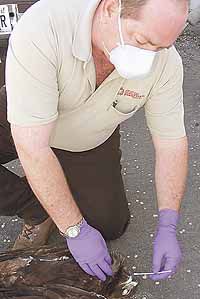| Darren Williams of the Utah Department of Wildlife Resources, takes a sample of fluids from a dead raptor so technicians can test the bird for West Nile Virus. |
Darren Williams is an urban manager for the Utah Division of Wildlife Resources. And the urban wildlife official recently had another job added to his list of duties.
As of last week, Williams has been trained to examine dead birds for signs of west Nile virus.
Utah is one of only five states where the virus, that started a westward trek in the United States in New Jersey in 1999, has not been detected.
Almost all the states surrounding Utah have identified cases of the virus. Therefore, the experts predict that it is only a matter of time before the virus shows up in the Beehive State.
And on the front lines of detecting the virus is urban wildlife manager Williams.
“I took the training last week because they wanted us to get started right away,” stated Williams as he put on a mask and gloves in preparation to check a dead raptor.
According to experts, the virus which is primarily passed to humans through the bite of mosquitos, travels from area to area via birds, which frequently die once they come down with the disease.
“People should be suspicious of dead birds they find,” warns Williams. “But they shouldn’t take it too far.”
“Not all birds are affected by the disease. Look for dead magpies, crows, ravens or any of the raptor species. Sparrows and starlings aren’t in the group we are looking for,” explains the urban wildlife manager.
Raptors are birds of prey.
In the event Williams is contacted, he goes with a kit out to the site to examine the bird. He must take a swab from within the animals mouth and then a culture is started to find if the bird has west Nile virus.
The virus itself is more deadly to birds and horses than it is to humans and people often get the disease and don’t even know they have it.
However, in a percentage of the reported cases, the disease can turn into encephalitis and kill a human.
The chances of the virus becoming a serious infection increases dramatically with age, point out officials.
Carbon County residents who are older than 50 years of age have a significantly greater chance of the virus becoming serious than a 19-year-old young adult. And when a person is older than 80 years of age, the chances are almost 20 times greater and can result in severe illness or death.
“People need to be careful around these dead birds,” indicates Williams. “In the last 24 hours of the birds life, they start to secret large amounts of fluid. It is then that the disease can even become airborne. That’s why we are very careful when we double bag these birds; air coming out of the bag as it is closed could even be dangerous. That’s why no one should touch these dead animals.”
This is also why Williams shows up at a residence not wearing full body protection, but he will be wearing special gloves and a mask.
Williams explains that the proper procedure is to contact the DWR and he, or someone else from the division will come out with a kit and remove the bird. Carbon County residents should not gather up the birds themselves and bring them in warnes Williams.
“I don’t want people to over react and get scared of any dead bird they see,” he states. “But caution should be exercised.”
Right now DWR representatives around the state are testing for the virus. In addition, many of the mosquito abatement districts have sentinel chickens in cages out in areas where mosquitos are known to breed.
For most wildlife and health officials it isn’t a question of if, but when it will be detected in the state.
“Right now we are just trying to detect it in Utah,” states Williams. “But once it is detected that doesn’t mean the sampling will be over. Even if it has shown up in the state, counties where it hasn’t appeared will keep testing until it does show up. That will continue until it is found in every county.”
It seems that for many people the biggest concern is their horses, because the death rate for equine animals is very high. However, any local horse owners should know that even though a vaccine has not been developed for humans, a very effective one has been built for horses.
The health department continues to monitor the entire situation, and information will be released as they learn more.

